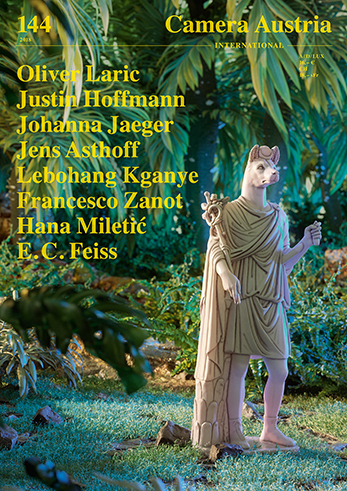Camera Austria International
144 | 2018
- JUSTIN HOFFMANN
Oliver Laric and His Archive of 3D Scans - OLIVER LARIC
- JENS ASTHOFF
Fossilized Foliage, Liquefied Time: On Motifs and Methods in Johanna Jaeger’s Photography - JOHANNA JAEGER
- FRANCESCO ZANOT
Family Ghosts - LEBOHANG KGANYE
- E. C. FEISS
Photography as Support System - HANA MILETIĆ

Preface
Photography has long since ceased being reduced to classical two-dimensional formats whose presentation solely is played out in the form of artwork mounted on walls. Preceding the actual artistic work is an elaborate conceptual and research-oriented practice that is an essential part of the work ultimately on show. Thus, the artists presented in Camera Austria International No. 144 likewise approach photography from what is often a process-based interest, querying the medium as to its performative qualities, which at times also reach into the digital and sculptural.
Entries
Forum
Presented by the editors:
Oliver Leu
Paula Artés
Alexandra Soldatova
Jenny Schäfer
Wenzel Stählin
Julia Gaisbacher
Exhibitions
Wolfgang Tillmans: How likely is it that only I am right in this matter?
David Zwirner, New York
Trisha Baga: Mollusca & The Pelvic Floor
Greene Naftali, New York
Danielle Dean: Bazar
47 Canal, New York
Martine Syms: Big Surprise
Bridget Donahue, New York
Danny Lyon: Wanderer
Gavin Brown’s Enterprise, New York
ORIT GAT
James Richards & Leslie Thornton: Crossing
Secession, Vienna
James Richards & Leslie Thornton: SPEED Künstlerhaus Stuttgart
Malmö Konsthall
DENISE HELENE SUMI
Cauleen Smith: Give It or Leave It
Institute of Contemporary Art, Philadelphia
Institute for Contemporary Art at Virgina Commonwealth University, Richmond
JACOB KORCZYNSKI
Michael Oppitz: Bewegliche Mythen
Kolumba, Cologne
MORITZ SCHEPER
The Black Image Corporation Osservatorio
Fondazione Prada, Milan
MARIACARLA MOLÈ
Volksfronten: steirischer herbst 2018
Various venues, Graz
RAIMAR STANGE
Persona Grata
Musée national de l’histoire de l’immigration, Paris
Musée d’art contemporain du Val-de-Marne, Vitry-sur-Seine
MICHÈLE COHEN HADRIA
Antarktika: An Exhibition on Alienation
Kunsthalle Wien, Vienna
JUNE DREVET
Klassenverhältnisse: Phantoms of Perception
Kunstverein in Hamburg
STEFANIE DIEKMANN
Richard Billingham’s Feature Film Debut “Ray & Liz” (2018)
Viennale, Vienna
RAINER BELLENBAUM
Moving Image Helen Levitt
Albertina, Vienna
PAULA WATZL
25 Jahre! Gemeinsam Geschichte(n) schreiben
Fotomuseum Winterthur
SONKE GAU
Stefanie Seibold: Centrefolds
Tiroler Künstler*schaft – Kunstpavillon, Innsbruck
KATJA KOBOLT
Sara Cwynar: Image Model Muse
Minneapolis Institute of Art
Milwaukee Art Museum
CHRISTINA SCHMID
Stillleben: Eigensinn der Dinge
Kunst Haus Wien
GUDRUN RATZINGER
Sigmar Polke: Fotografien 70 – 80
Museum Morsbroich, Leverkusen
STEVEN HUMBLET
Photo/Politics/Austria
museum moderner kunst stiftung ludwig Wien, Vienna
HERBERT JUSTNIK
Astrid Klein: transcendental homeless centralnervous
Sammlung Falckenberg / Deichtorhallen, Hamburg-Harburg
JOCHEN BECKER
Imogen Stidworthy: Dialogues with People
Württembergischer Kunstverein Stuttgart
KATRIN MUNDT
James N. Kienitz Wilkins: Hearsays
Gasworks, London
CHRIS FITE-WASSILAK
Caline Aoun: seeing is believing
MAXXI – Museo nazionale delle arti del XXI secolo, Rome
ARNISA ZEQO
Books
»Sollte ein Buch zum Film werden, ist etwas anderes geworden […]« – Über Bücher von Franz Greno zu Filmen von Alexander Kluge und Rainer Werner Fassbinder
Alexander Kluge: Die Patriotin. Texte / Bilder 1–6
Zweitausendeins, Frankfurt am Main 1979
Der Film BERLIN Alexanderplatz. Ein Arbeitsjournal von Rainer Werner Fassbinder und Harry Baer
Zweitausendeins, Frankfurt am Main 1980
Alexander Kluge: Die Macht der Gefühle
Zweitausendeins, Frankfurt am Main 1984
JAN WENZEL
Kenneth T. Walsh: Ultimate Insiders. White House Photographers and How They Shape History
Routledge, New York / London, 2018
KATHARINA SYKORA
Philipp Anz, Jules Spinatsch,Viola Zimmermann (Hg.): Schmieren / Kleben. Aus dem Archiv KKIII der Stadtpolizei Zürich 1976–1989
Edition Patrick Frey, Zürich 2018
EIKO GRIMBERG
Victor Burgin: The Camera. Essence and Apparatus
MACK, London 2018
TACO HIDDE BAKKER
Imprint
Publisher: Reinhard Braun
Owner: Verein CAMERA AUSTRIA. Labor für Fotografie und Theorie.
Lendkai 1, 8020 Graz, Österreich
Editor-in-Chief: Christina Töpfer.
Editor: Margit Neuhold.
Translations: Dawn Michelle d’Atri, Ben Bazalgette, Eva Dewes, Nicholas Huckle, Wilfried Prantner.
English Proofreading: Dawn Michelle d’Atri.
Acknowledgments: Paula Artés, Jens Asthoff, Thomas Bernardet, Emilie Demon, E. C. Feiss, Julia Gaisbacher, Damon Garstang, Justin Hoffmann, Johanna Jaeger, Lebohang Kganye, Lena Kinast, Oliver Laric, Erin Leland, Oliver Leu, Hana Miletić, Matthias Reichelt, Ariel Reichman, Sandra Križić Roban, Jenny Schäfer, Franziska Schmidt, Alexandra Soldatova, Wenzel Stählin, Sophie Thun, Henri Vergon, Anna Witt, Francesco Zanot, Daniela Zehetner, Ondrej Zunka.
Copyright © 2018
No parts of this magazine may be reproduced without publisher’s permission.
Camera Austria International does not assume any responsibility for submitted texts and original materials.
ISBN 978-3-902911-47-6
ISSN 1015 1915
GTIN 4 19 23106 1600 5 00144







